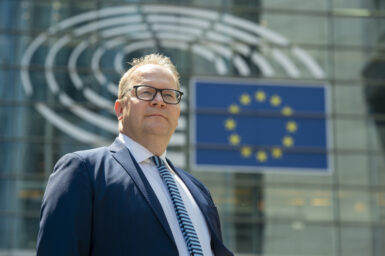As the war in Ukraine reshapes trafficking routes and fuels regional instability, Europe’s illicit drug market is transforming at unprecedented speed. Drug market analyst Tim Surmont tells EU Perspectives that domestic synthetic production, conflict-driven vulnerabilities and a surge in cocaine-linked violence are now converging into a strategic challenge for the entire Union.
For decades, Europe’s drug market was defined by its role as a destination. That reality has shifted. Mr Surmont explains that the most striking evolution is the expansion and diversification of drug production inside the European Union. Methamphetamine, once an occasional anomaly, is now part of the region’s regular production landscape. Even more significantly, synthetic cathinones—substances like 3-MMC, 4-CMC, or mephedrone—are increasingly manufactured within the EU itself.
These synthetic stimulants mimic the effects of traditional drugs, yet many of their long-term health consequences remain poorly understood. Criminal networks exploit the flexibility of small-scale chemical production, adapting formulas and precursor sources with speed that often outpaces regulation and health monitoring.
This diversification is happening close to consumer markets, reducing transport risks and allowing criminal groups to respond swiftly to demand. It also marks a shift in the EU’s strategic posture: Europe must now confront not only external trafficking but the internal innovation of synthetic drug laboratories.
You might be interested
Violence at Europe’s borders
Geopolitical instability has become inseparable from Europe’s drug dynamics. The Russian invasion of Ukraine has not only disrupted trafficking routes, forcing networks to shift their traditional paths; it has also created a reservoir of vulnerable individuals who may be drawn into criminal activity. Tim Surmont, analyst at the European Union Drugs Agency (EUDA) notes that conflict uproots populations, strips them of stable livelihoods, and exposes them to recruitment by organised crime. These groups exploit chaos and uncertainty, using border regions as logistical corridors or production zones.
While there is no definitive evidence that the Russian state itself is directly manipulating drug markets in Europe, criminal groups with Russian or Ukrainian links are active. Distinguishing their nationality or affiliation in conflict zones is increasingly difficult. Still, the war’s impact is clear: it reshapes the criminal landscape and injects volatility into markets already marked by adaptability and opportunism.
If Europe is to manage the pressures on its borders, cooperation with the Western Balkans is indispensable. Mr Surmont emphasises that criminal networks pay no attention to EU borders; therefore, neither can European security policy. The Western Balkans remain a crucial gateway to Europe’s markets, especially through the Mediterranean, where smaller ports offer fertile ground for trafficking.
Cocaine, Europe’s stalwart
The region also hosts criminal groups with established operations across the EU, from Albanian-speaking networks operating in Belgium, the Netherlands and the UK to Serbian groups active in Spain’s cannabis economy. EUDA’s long-standing partnerships with Western Balkan countries are therefore not simply technical exercises but strategic investments in the stability of the wider region. As enlargement debates intensify, these collaborations will play a decisive role in safeguarding Europe’s internal security.
Cocaine’s central role in Europe’s security debate is no longer speculative. It is visible in the daily operations of police forces, in the strain on judicial systems, and in the financial power that trafficking grants to transnational criminal actors.
The extraordinary availability of cocaine across the continent surfaces as perhaps the most urgent challenge the continet faces. Its profitability has driven an intense competition among criminal groups, especially around major and minor ports in the North Sea and the Mediterranean. Violence has escalated accordingly. Shootings, bombings, assassinations and intimidation have become more frequent, especially in cities tied to maritime logistics.
Fentanyl remains US specialty
Mr Surmont stresses that this trend is unlikely to subside without a coordinated, cross-sectoral approach. Law enforcement can disrupt networks, but without addressing the demand driving the trade, the underlying incentives remain intact.
Public discourse also often tends to draw parallels between Europe and the devastating opioid crisis in the United States. Mr Surmont is careful to correct this perception. Instead, its presence is mostly confined to small, specific communities of opioid users, often through heroin adulteration. The structural drivers of the American crisis especially the widespread overprescription of opioid medications are absent in Europe.
Europe does not experience fentanyl as a mass-consumption substance in the way the US does. — Tim Surmont, analyst at EUDA
However, other synthetic opioids such as nitazenes are emerging, particularly in larger cities. These substances carry high potency and unpredictable risks. While still a limited phenomenon, their appearance underscores the need for vigilance, especially if heroin supplies fluctuate due to developments in Afghanistan or shifts in global trafficking routes.
‘Quiet’ cannabis revolution
Mr Surmont was cautious when asked about potential links between drug trafficking and disinformation campaigns. EUDA monitors online marketplaces on the darknet and surface web for drug sales, but not broader influence operations. Yet he acknowledges that the financial ecosystems surrounding organised crime are deeply interconnected.
The profits derived from drug trafficking can move across sectors, potentially funding cybercrime, weapons procurement or other criminal enterprises. Some groups may allocate resources to online manipulation or digital harassment. For clearer view of this intersection, the analyst suggests, Europol remains the primary reference point.
While synthetic drugs and cocaine dominate headlines, Europe is witnessing a quieter but equally consequential transformation in cannabis. The increasing availability of highly potent products from North America, combined with the spread of semi-synthetic cannabinoids such as HHC, poses new challenges. These substances are often marketed as harmless “legal alternatives”, creating confusion among consumers and undermining public health messaging.
Legal status does not equal safety
At the same time, national legalisation experiments—most notably in Germany, Luxembourg and Malta—are altering the cultural and regulatory landscape. Mr Surmont warns that robust prevention campaigns must accompany the shift toward legal markets. The goal is not to roll back reform but to avoid sending misleading signals that legal status equals safety. The potential long-term psychological and environmental impacts of high-potency cannabis products remain insufficiently understood, making this an area that EU institutions will need to monitor closely in the coming years.
Europe enters 2026 with a drug market defined by fragmentation, innovation and geopolitical turbulence. Synthetic production is expanding, cocaine continues to fuel violence, and the war in Ukraine continues to reshape regional vulnerabilities. Cannabis regulation is evolving in ways that require careful public outreach, while the digital dimension of organised crime grows ever more complex.
The future will require a blend of law enforcement, public health, international cooperation and digital governance. Drug markets are no longer a siloed issue; they touch on security, economics, diplomacy and technology. As the EU prepares for 2026, it must acknowledge the full strategic dimension of the challenge ahead.




